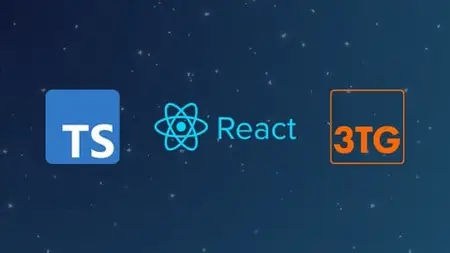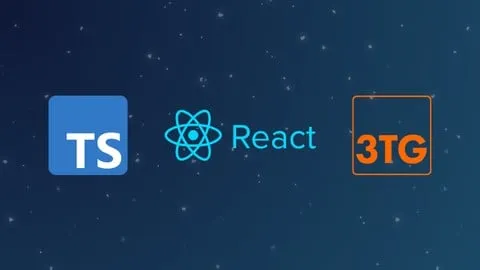Mastering Typescript And React Testing With 3Tg
Published 8/2025
MP4 | Video: h264, 1920x1080 | Audio: AAC, 44.1 KHz
Language: English | Size: 1.12 GB | Duration: 2h 38m
Published 8/2025
MP4 | Video: h264, 1920x1080 | Audio: AAC, 44.1 KHz
Language: English | Size: 1.12 GB | Duration: 2h 38m
Automate Unit & Component Testing with Markdown and 3TG
What you'll learn
Build robust, maintainable unit and render tests for TypeScript and React projects using 3TG software
Understand how to design and generate comprehensive test templates that cover both common and edge cases effectively
Improve code quality and reliability by mastering advanced testing strategies, including mocks, async flows, and state management
Learn to configure and customize 3TG configurations to tailor test generation for your specific project needs
Requirements
Basic understanding of JavaScript and TypeScript programming concepts
Familiarity with React framework and component-based architecture
Some experience writing unit tests or basic knowledge of testing principles (helpful but not mandatory)
Access to a development environment with Node.js (v18 or later) installed
A code editor like Visual Studio Code recommended for following along
Willingness to learn about testing tools
Description
Mastering TypeScript and React Testing with 3TGAre you a software developer or QA engineer eager to elevate your testing skills and boost your project’s reliability? Welcome to Mastering TypeScript and React Testing with 3TG, a comprehensive course designed to introduce you to 3TG — a powerful, next-generation tool that revolutionizes the way you create and manage tests for TypeScript functions and React components.In today’s fast-paced development environments, writing effective and maintainable tests is critical. 3TG simplifies this by enabling automated generation of unit and component test templates based on your source code and clear, human-readable functional requirements written in Markdown. This course will guide you step-by-step through the process of crafting behavior-focused specifications and transforming them into actionable test cases using 3TG, embracing the principles of Test-Driven Development (TDD) and Behavior-Driven Development (BDD).You will learn how to write functional requirements that are not only easy to read and maintain but also serve as an improved UX layer over traditional configuration files. These Markdown specifications allow you to mix detailed documentation with structured test case definitions, making your tests more understandable and collaborative across teams.The course covers essential techniques for generating both unit tests for individual functions and component tests for React apps, ensuring your code behaves exactly as intended. You’ll discover how to integrate 3TG-generated tests smoothly into your daily workflow and Continuous Integration/Continuous Deployment (CI/CD) pipelines, enabling automated quality checks and faster feedback loops.Through practical lessons, you’ll learn how to:Write clear, behavior-focused functional requirements in markdownUse 3TG to generate comprehensive unit and component test templates from your code and specificationsIntegrate generated tests smoothly into your development and CI/CD workflowsEmploy best practices in Behavior-Driven Development (BDD) and TDD for robust software qualityCustomize configurations and troubleshoot common pitfalls with 3TGCustomization is key for any real-world project. We’ll dive into configuring 3TG to suit your specific needs, managing configuration files, and troubleshooting common issues such as license activation, file overwrites, and mocking strategies. By the end of this course, you’ll be equipped with practical skills to avoid common pitfalls and maximize your testing efficiency.Whether you’re a beginner to automated testing or an experienced developer looking to streamline your testing process, this course offers actionable insights and hands-on experience that will empower you to confidently adopt TDD practices in TypeScript and React projects.Enroll in “Mastering TypeScript and React Testing with 3TG” today and take the next step toward creating robust, reliable, and well-tested software — faster and easier than ever before!
Overview
Section 1: Course Objective
Lecture 1 Course Objective
Section 2: Introduction to TypeScript Testing
Lecture 2 Why Tests Matter: Quality, Speed, Confidence
Lecture 3 Limitations of Auto-Generated Tests
Lecture 4 Types of Software Testing
Lecture 5 Meet Jest, the Testing Framework
Lecture 6 Meet Vitest, the Testing Framework
Lecture 7 Comparing Jest and Vitest Testing Frameworks
Lecture 8 Meet React Testing Library
Lecture 9 Working with Mocks
Lecture 10 Best Practices and Pitfalls
Section 3: Unit Testing for TypeScript
Lecture 11 What Is Unit Testing?
Lecture 12 Anatomy of a Unit Test File
Lecture 13 False Positive Tests
Section 4: Component Testing for React
Lecture 14 What Is Component Testing?
Lecture 15 Rendering components and interacting with the DOM
Lecture 16 Handling async flows, state updates, and side effects
Section 5: 3TG
Lecture 17 Philosophy and Goals of the 3TG Test Generator
Lecture 18 How 3TG Integrates into Modern Development
Section 6: Buy, Installation and Setup of 3TG
Lecture 19 Choosing the Right 3TG License
Lecture 20 How to Order Licenses
Lecture 21 Installing 3TG CLI
Lecture 22 Installing 3TG VSCode Extension
Section 7: 3TG Command-Line Interface
Lecture 23 3TG Command-line Options and Flags Explained
Lecture 24 Using the 3TG CLI to Generate Unit Tests
Lecture 25 Using the 3TG CLI to Generate Component Tests
Lecture 26 Using the 3TG CLI to Mock Functions
Lecture 27 Using the 3TG CLI to Mock Components
Section 8: 3TG VSCode Extension
Lecture 28 3TG VSCode Extension Explained
Lecture 29 Using 3TG in VSCode to Generate Unit Tests
Lecture 30 Using 3TG in VSCode to Generate Component Tests
Lecture 31 Using 3TG in VSCode to Mock Functions
Lecture 32 Using 3TG in VSCode to Mock Components
Section 9: Writing and Understanding 3TG Test Templates
Lecture 33 3TG Test File Structure for Functions
Lecture 34 3TG Test File Structure for Components
Lecture 35 Customizing templates for your codebase
Section 10: Understanding 3TG Configuration Files
Lecture 36 Understanding 3TG Configuration Files
Lecture 37 Test Code Generation
Lecture 38 Test Execution Control
Lecture 39 Mocking Behavior
Lecture 40 Test Inclusion and Naming
Lecture 41 Generated Test Code
Lecture 42 Code Import and Path Resolution
Lecture 43 Rules for Test Values
Lecture 44 Test Value Generation Limits
Lecture 45 Test Value Generation
Lecture 46 Test Value Assertions
Lecture 47 Logging and Diagnostics
Lecture 48 Testing Framework Integration
Lecture 49 How to Validate Your JSON Config
Section 11: Using Markdown Functional Requirements
Lecture 50 What Are Functional Requirements Files?
Lecture 51 Writing Functional Requirements for Functions
Lecture 52 Writing Functional Requirements for Components
Section 12: Integrating Test Generation into Your CI/CD
Lecture 53 Overview of CI/CD and Its Importance
Lecture 54 Test Generation in Your CI/CD Pipeline
Section 13: Before You Go: Fixes & Final Thoughts
Lecture 55 Troubleshooting 3TG CLI
Lecture 56 Troubleshooting 3TG VSCode Extension
Lecture 57 Summary
This course is designed for software developers, QA engineers, and technical leads who want to improve the quality and reliability of their TypeScript and React applications through automated testing. Whether you’re a beginner eager to understand testing fundamentals or an experienced developer looking to streamline your testing workflow, this course will provide practical tools and techniques. Ideal learners include:,Frontend developers working with React and TypeScript seeking to write better tests,Engineers wanting to automate test generation to save time and reduce manual effort,QA professionals looking to deepen their knowledge of unit and integration testing strategies,Anyone interested in improving their CI/CD pipelines by integrating test automation,Developers aiming to master 3TG, Jest, and Vitest to enhance test coverage and maintainability,If you want to build reliable, maintainable tests and confidently ship high-quality software, this course is for you.



